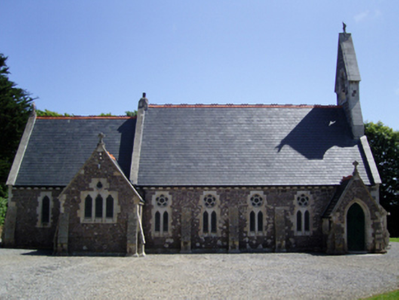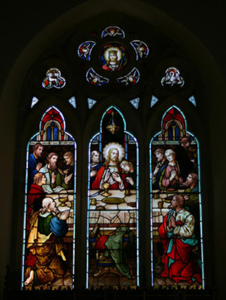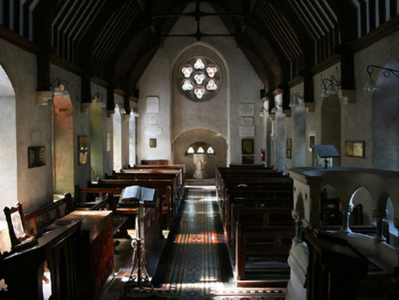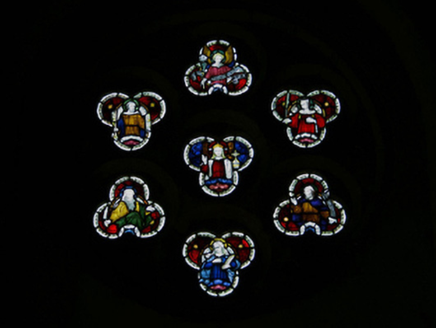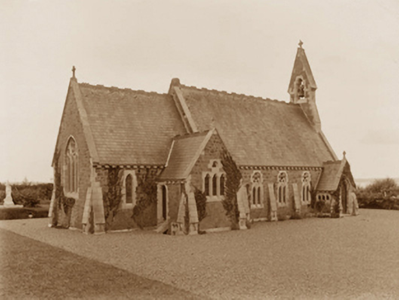Survey Data
Reg No
15704409
Rating
Regional
Categories of Special Interest
Architectural, Artistic, Historical, Social, Technical
Original Use
Church/chapel
In Use As
Church/chapel
Date
1875 - 1880
Coordinates
272870, 109386
Date Recorded
14/06/2009
Date Updated
--/--/--
Description
Detached seven-bay double-height Representative Church Body Church of Ireland church, designed 1877; built 1877-8; dated 1878, on a rectangular plan comprising five-bay double-height nave opening into two-bay double-height chancel (east) with single-bay single-storey projecting porch (north-west). Restored, 2007-8. Replacement pitched slate roofs with part perforated crested terracotta ridge tiles, cut-limestone "Cavetto" coping to gables on "Hollow" kneelers including cut-limestone "Cavetto" coping to gable to entrance (west) front on "Hollow" kneelers with buttressed gabled bellcote to apex framing cast-bronze bell, and uPVC rainwater goods on cut-limestone "Bowtell" corbels. Part repointed tuck pointed snecked "Old Red Sandstone" walls on cut-limestone chamfered plinth with dwarf buttresses including clasping dwarf buttresses to corners having cut-limestone "slated" coping. Lancet window openings in bipartite arrangement below cinquefoil "Roses", cut- or hammered limestone block-and-start surrounds having chamfered reveals framing iron mesh storm panels over fixed-pane fittings having stained glass margins centred on square glazing bars. Pointed-arch window opening to chancel (east), lichen-spotted cut- or hammered limestone block-and-start surround having chamfered reveals framing iron mesh storm panels over fixed-pane fittings having stained glass margins centred on leaded stained glass panels. Lancet window openings to "cheeks", cut- or hammered limestone block-and-start surrounds having chamfered reveals framing iron mesh storm panels over fixed-pane fittings having leaded stained glass panels. Trefoil-detailed "Rose Window" to entrance (west) front with cut- or hammered limestone block-and-start surround having chamfered reveals framing iron mesh storm panels over fixed-pane fittings having stained glass margins centred on leaded stained glass panels. Full-height interior open into roof with cut-veined white marble wall monuments centred on quatrefoil-detailed baptismal font on an octagonal plan on clustered colonette pedestal, encaustic tiled central aisle between trefoil-detailed timber pews, polished brass wall monuments, exposed trefoil-arch braced collared timber roof construction on "Hollow" corbels with wind braced rafters to ceiling on carved timber cornice, trefoil-detailed pulpit on a bowed plan with Gothic-style timber clerk's desk, and pointed-arch chancel arch framing encaustic tiled stepped dais to chancel (east) with wrought iron-detailed barley twist balusters supporting polished brass communion railing centred on cloaked altar below stained glass memorial "East Window" (1900). Set in landscaped grounds with trefoil-detailed piers to perimeter having lichen-covered roll moulded gabled capping.
Appraisal
A church erected to a design by James Franklin Fuller (1835-1924) of Great Brunswick Street [Pearse Street], Dublin (Irish Builder 1877, 158), representing an integral component of the later nineteenth-century built heritage of south County Wexford with the architectural value of the composition, one superseding 'an old church at an inconvenient distance from [Duncannon]' (Building News and Engineering Journal 1878, 251), confirmed by such attributes as the rectilinear plan form, aligned along a slightly skewed liturgically-correct axis; the construction in a ruby-coloured "Old Red Sandstone" offset by silver-grey dressings not only demonstrating good quality workmanship, but also producing a lively two-tone palette; the slender profile of the coupled openings underpinning a "medieval" Gothic theme with the chancel defined by a cusped "East Window"; and the handsome bellcote embellishing the roofline as a picturesque eye-catcher in the landscape. Having been well maintained, the elementary form and massing survive intact together with substantial quantities of the original fabric, both to the exterior and to the interior where contemporary joinery; restrained wall monuments; stained glass supplied by Clayton and Bell (formed 1857) of London; encaustic tile work; a cloaked altar; and a vibrant "East Window" supplied (1900) by Franz Mayer and Company (founded 1847) of Munich and London, all highlight the considerable artistic potential of the composition: meanwhile, an exposed timber roof construction pinpoints the engineering or technical dexterity of a church forming part of a neat self-contained group alongside an adjacent rectory (see 15704410) with the resulting ecclesiastical ensemble making a pleasing visual statement in a sylvan street scene.




